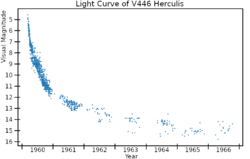Astronomy:V446 Herculis
| Observation data Equinox J2000.0]] (ICRS) | |
|---|---|
| Constellation | Hecules |
| Right ascension | 18h 57m 21.59s[1] |
| Declination | +13° 14′ 29.3″[1] |
| Astrometry | |
| Distance | 1361+185 −100[2] pc |
| Characteristics | |
| Variable type | Nova, Dwarf Nova[3] |
| Other designations | |
V446 Her, Nova Her 1960, AAVSO 1852+13 | |
| Database references | |
| SIMBAD | data |
V446 Herculis was a nova in the constellation Hercules in 1960. It reached magnitude 2.8. The nova was first observed by Olaf Hassel in the early morning hours of 7 March 1960, when it was a 5th magnitude star. Pre-discovery photographs showed that it was about three days past peak brightness, and had faded by 2 magnitudes during that time. The star was so near the border between the constellations of Hercules and Aquila that accurate measurements of its position were needed to determine which constellation contained it.[4]
V446 Herculis was the first nova to have the degree of linear polarization of its light measured. It was determined that the polarization did not arise from the star itself.[5][6]
Like all novae, V446 Herculis is a close binary star system with a "donor" star transferring matter to its white dwarf companion. In the case of V446 Herculis the donor star is a red dwarf[3] and the pair's orbital period is 4.97 hours.[7] Unlike many novae, V446 Herculis is not an eclipsing binary, but it does show dwarf nova outbursts every 13 to 30 days.[3]
References
- ↑ 1.0 1.1 "V446 Her". SIMBAD. Centre de données astronomiques de Strasbourg. http://simbad.u-strasbg.fr/simbad/sim-basic?Ident=V446+Her.
- ↑ Schaefer, Bradley E. (December 2018). "The distances to Novae as seen by Gaia". Monthly Notices of the Royal Astronomical Society 481 (3): 3033–3051. doi:10.1093/mnras/sty2388. Bibcode: 2018MNRAS.481.3033S.
- ↑ 3.0 3.1 3.2 Honeycutt, R.K.; Robertson, J.W.; Kafka, S. (April 2011). "The Dwarf Nova Outbursts of Nova Her 1960 (=V446 Her)". The Astronomical Journal 141 (4): 121. doi:10.1088/0004-6256/141/4/121. Bibcode: 2011AJ....141..121H. https://iopscience.iop.org/article/10.1088/0004-6256/141/4/121. Retrieved 2 December 2020.
- ↑ Mayall, M.W. (December 1963). "Variable Star Notes". Journal of the Royal Astronomical Society of Canada 57: 279. Bibcode: 1963JRASC..57..279M. http://adsabs.harvard.edu/full/1963JRASC..57..279M. Retrieved 2 December 2020.
- ↑ Grigorian, K.H.; Vardanian, R.A. (January 1961). "Photometric, Colorimetric and Polarimetric Study of the Nova of Hercules 1960". Communications of the Byurakan Astrophysical Observatory (ComBAO) 29: 39–50. Bibcode: 1961CoBAO..29...39G. https://ui.adsabs.harvard.edu/abs/1961CoBAO..29...39G. Retrieved 9 January 2021.
- ↑ Harvey, E.J.; Redman, M.P.; Darnley, M.J.; Williams, S.C.; Berdyugin, A.; Piirola, V.E.; Fitzgerald, K.P.; O'Connor, E.G.P. (March 2018). "Polarimetry and Spectroscopy of the 'Oxygen Flaring' DQ Herculis-like nova: V5668 Sagittarii (2015)". Astronomy & Astrophysics 611: A3. doi:10.1051/0004-6361/201731741. Bibcode: 2018A&A...611A...3H.
- ↑ Thorstensen, John R.; Taylor, Cynthia J. (March 2000). "Spectroscopy and orbital periods of the old novae V533 Herculis, V446 Herculis and X Serpentis". Monthly Notices of the Royal Astronomical Society 312 (3): 629–637. doi:10.1046/j.1365-8711.2000.03230.x. Bibcode: 2000MNRAS.312..629T.
External links
 |



